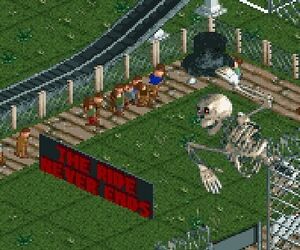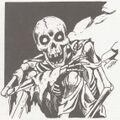Skeleton: Difference between revisions
1d4chan>Nubnuber (Added D&D images) |
1d4chan>Nubnuber |
||
| Line 19: | Line 19: | ||
<gallery> | <gallery> | ||
Skeleton 1e.jpg | Skeleton 1e.jpg | ||
Skeleton MCV1.jpg | |||
Skeleton MM 2e.png | Skeleton MM 2e.png | ||
Giant skeleton MM 2e.png | Giant skeleton MM 2e.png | ||
Revision as of 23:09, 27 March 2021

"Spooky, scary skeletons send shivers down your spine."
"Shrieking skulls will shock your soul, and seal your doom tonight."
- – Andrew Gold
A skeleton is a rigid supporting structure. It usually assumes the context of supporting a living creature, either from the inside (an endoskeleton) or the outside (an exoskeleton), but the term is also used figuratively to refer to the supporting structure of a non-living thing (e.g. the skeleton of a building). You might not realize it, but there is a skeleton inside you!
Because they are hard and made of inorganic calcium and other minerals, they tend to persist after the death of their organism -- potentially for millions of years, if conditions are right. Because of this, they are often identified with death; in fact, the word skeleton comes from the Greek word for "mummy" or "dried body". Grim Reapers and other personifications of death tend to be skeletons, or at least have skulls for heads, and skeletons in general are spooky and scary to most people.
Skeletons are also a favorite choice of minion for necromancers -- they have no flesh, which means they don't rot or smell bad, and makes them slightly more resilient to slashing damage (though hammers are quite effective, and as undead, holy damage is also a good choice; some paladins call them 'hammer fodder' for this very reason). They also tend to be just as fast as they were in life, unlike the shambling zombies, making them useful for time-critical tasks as well as fast-paced combat. Additionally, skeletons are just smart enough to wield weapons, normally the ones they used in life.
Not all skeletons are of humanoids. Animal skeletons are better combat minons and make tireless beasts of burden. The necromancy focused armies of Eberron's Karrnath often employ skeleton horses which, in addition to being tireless, are a stable enough ride to rest in the saddle of. Dragon skeletons are popular thematically since they are so long lived and tough that it can convey just how old a location is or how tough whatever killed them was. Player accessible necromancy options rarely support undead dragons well however.
One particularly disturbing version of skeletons is the exoskeleton of insects, arachnids, and crustaceans (among others). While on most creatures the skeleton is inside, an exoskeleton is on the outside. These can be reanimated by necromancers as well and are more difficult to distinguish from the living version. Beware a Swarm of exoskeleton bugs.
Lich are a subtype of skeleton that's both intelligent and a good caster. Dracolich is a subtype of that. Early D&D also had an elite skeleton called the Skeleton Warrior.
A final word of warning, skeletons tend to be unpredictable; they are equally likely to make lame bone-based puns, violently disembowel you, or show up to your concert because you opted to buy a xylophone instead of a marimba.
Gallery
-
-
-
-
-
-
-
-
Sometimes a skeleton just wants to have some fun.
-
Skeletons are not only inside humans, but other nightmarish species as well.
See Also
- Skeleton Warrior, an upgraded skeleton from AD&D, in order to make the skeleton still scary at higher levels.
- Deep Rot, a skeleton-based computer constructed by a necromancer with a penchant for mad science.
- Spooky Scary Skeletons, a song that is guaranteed to play or at least be mentioned in any thread involving skeletons. It might be 2spooky4u.
- Spooky Skeletons vs Sickass Demons, a FATE scenario that a fa/tg/uy wrote in honor of this meme








